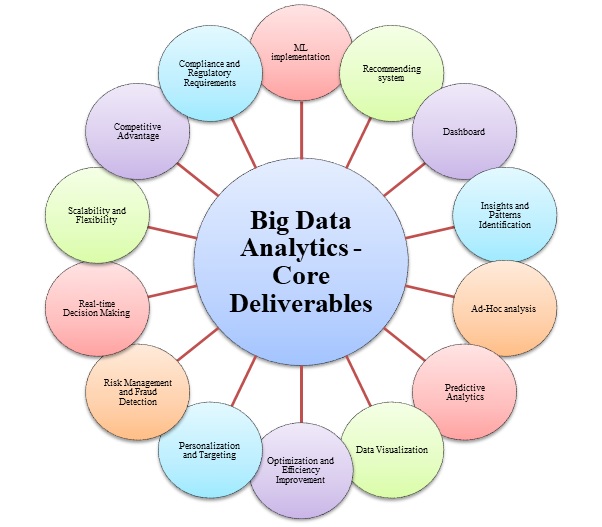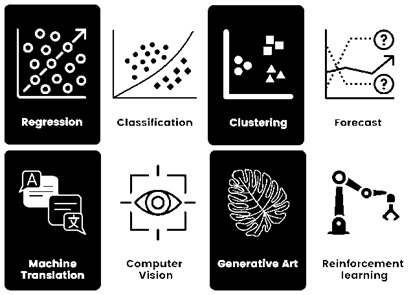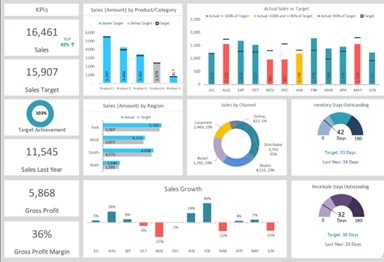
- Big Data Analytics - Home
- Big Data Analytics - Overview
- Big Data Analytics - Characteristics
- Big Data Analytics - Data Life Cycle
- Big Data Analytics - Architecture
- Big Data Analytics - Methodology
- Big Data Analytics - Core Deliverables
- Big Data Adoption & Planning Considerations
- Big Data Analytics - Key Stakeholders
- Big Data Analytics - Data Analyst
- Big Data Analytics - Data Scientist
- Data Analytics - Problem Definition
- Big Data Analytics - Data Collection
- Big Data Analytics - Cleansing data
- Big Data Analytics - Summarizing
- Big Data Analytics - Data Exploration
- Big Data Analytics - Data Visualization
- Big Data Analytics Methods
- Big Data Analytics - Introduction to R
- Data Analytics - Introduction to SQL
- Big Data Analytics - Charts & Graphs
- Big Data Analytics - Data Tools
- Data Analytics - Statistical Methods
- Advanced Methods
- Machine Learning for Data Analysis
- Naive Bayes Classifier
- K-Means Clustering
- Association Rules
- Big Data Analytics - Decision Trees
- Logistic Regression
- Big Data Analytics - Time Series
- Big Data Analytics - Text Analytics
- Big Data Analytics - Online Learning
- Big Data Analytics Useful Resources
- Big Data Analytics - Quick Guide
- Big Data Analytics - Resources
- Big Data Analytics - Discussion
Big Data Analytics - Core Deliverables
Big data analytics entails processing and analysing large and diverse datasets to discover hidden patterns, correlations, insights, and other valuable information. As mentioned in the big data life cycle, some core deliverables of big data analytics are mentioned in below image −

Machine Learning Implementation
This could be a classification algorithm, a regression model or a segmentation model.

Recommending System
The objective is to develop a system that can recommend options based on user behaviour. For example on Netflix, based on users' ratings for a particular movie/web series/show, related movies, web series, and shows are recommended.
Dashboard
Business normally needs tools to visualize aggregated data. A dashboard is a graphical representation of data which can be filtered as per users' needs and results are reflected on screen.

For example, a sales dashboard of a company may contain filter options to visualise sales nation-wise, state-wise district-wise, zone-wise or sales product etc.
Insights and Patterns Identification
Big data analytics identifies trends, patterns, and correlations in data that can be used to make more informed decisions. These insights could be about customer behaviour, market trends, or operational inefficiencies.
Ad-Hoc Analysis
Ad-hoc analysis in big data analytics is a process of analysing data on the fly or spontaneously to answer specific, immediate queries or resolve ad-hoc inquiries. Unlike traditional analysis, which relies on predefined queries or structured reporting, ad hoc analysis allows users to explore data interactively, without the requirement for predefined queries or reports.
Predictive Analytics
Big data analytics can forecast future trends, behaviours, and occurrences by analysing previous data. Predictive analytics helps organisations to anticipate customer needs, estimate demand, optimise resources, and manage risks.
Data Visualization
Big data analytics entails presenting complex data in visual forms like charts, graphs, and dashboards. Data visualisation allows stakeholders to better grasp and analyse the data insights graphically.
Optimization and Efficiency Improvement
Big data analytics enables organisations to optimise processes, operations, and resources by identifying areas for improvement and inefficiencies. This could include optimising supply chain logistics, streamlining manufacturing processes, or improving marketing strategies.
Personalization and Targeting
Big data analytics allows organisations to personalise their products, services, and marketing activities based on individual preferences and behaviour by analysing massive amounts of customer data. This personalised strategy increases customer satisfaction and marketing ROI.
Risk Management and Fraud Detection
Big data analytics can detect abnormalities and patterns that indicate fraudulent activity or possible threats. This is especially crucial in businesses like finance, insurance, and cybersecurity, where early discovery can save large losses.
Real-time Decision Making
Big data analytics can deliver insights in real or near real-time, enabling businesses to make decisions based on data. This competence is critical in dynamic contexts where quick decisions are required to capitalise on opportunities or manage risks.
Scalability and Flexibility
Big data analytics solutions are built to manage large amounts of data from different sources and formats. They provide scalability to support increasing data quantities, as well as flexibility to react to changing business requirements and data sources.
Competitive Advantage
Leveraging big data analytics efficiently can give firms a competitive advantage by allowing them to innovate, optimise processes, and better understand their consumers and market trends.
Compliance and Regulatory Requirements
Big data analytics could help firms in ensuring compliance with relevant regulations and standards by analysing and monitoring data for legal and ethical requirements, particularly in the healthcare and finance industries.
Overall, the core deliverables of big data analytics are focused on using data to drive strategic decision-making, increase operational efficiency, improve consumer experiences, and gain a competitive advantage in the marketplace.